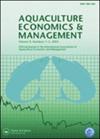Economic history of U.S. catfish farming: Lessons for growth and development of aquaculture
IF 3.8
2区 经济学
Q1 AGRICULTURAL ECONOMICS & POLICY
引用次数: 39
Abstract
Abstract Catfish farming continues to be the largest segment of U.S. aquaculture, and U.S. catfish farmers have demonstrated resilience and resourcefulness in adapting to changing economic conditions. Commercial production began in the 1950s–1960s, with growth leading to processing and marketing challenges in the 1970s. By the early 1980s, the key production, processing, and marketing pieces were in place to transform catfish farming into a major enterprise. Keys included development of efficient aerators, nutritionally complete feeds, multiple-batch production providing year-round supply of fish, processing innovations, and creation of The Catfish Institute (TCI) for marketing and public relations. The successful expansion into nontraditional catfish markets attracted competition of pangasius catfish imported from Vietnam by U.S. seafood importers, free riding on successful marketing programs. The 2003–2013 contraction of the U.S. industry was the combined effect of four external economic shocks; trough of price cycle; 2001 recession; September 11 terrorist attacks; and Vietnamese pangasius imports. Prices fell to historical lows and remained below production cost for 3 years. Adoption of intensive systems (split ponds, intensive aeration) that reduced costs led to steady growth from 2014 to 2019. Lessons for U.S. aquaculture include the importance of fingerling/seed technologies, farmer associations, research, Extension, marketing, and state/federal support.美国鲶鱼养殖的经济史:水产养殖增长和发展的经验教训
摘要鲶鱼养殖仍然是美国水产养殖的最大部分,美国鲶鱼养殖户在适应不断变化的经济条件方面表现出了韧性和足智多谋。商业生产始于20世纪50年代至60年代,20世纪70年代的增长带来了加工和营销方面的挑战。到20世纪80年代初,关键的生产、加工和营销环节已经到位,将鲶鱼养殖转变为一家大型企业。关键包括开发高效曝气器、营养完整的饲料、提供全年鱼类供应的多批次生产、加工创新,以及创建用于营销和公共关系的鲶鱼研究所(TCI)。向非传统鲶鱼市场的成功扩张吸引了美国海鲜进口商从越南进口的pangasius鲶鱼的竞争,这得益于成功的营销计划。2003-2013年美国工业的萎缩是四次外部经济冲击的综合影响;价格周期低谷;2001年经济衰退;9·11恐怖袭击;以及越南进口的pangasius。价格跌至历史低点,并在3年内一直低于生产成本。2014年至2019年,采用降低成本的强化系统(分流池、强化曝气)实现了稳定增长。美国水产养殖的经验教训包括鱼种/种子技术、农民协会、研究、推广、营销和州/联邦支持的重要性。
本文章由计算机程序翻译,如有差异,请以英文原文为准。
求助全文
约1分钟内获得全文
求助全文
来源期刊

Aquaculture Economics & Management
FISHERIES-
CiteScore
7.30
自引率
17.90%
发文量
21
期刊介绍:
Aquaculture Economics and Management is a peer-reviewed, international journal which aims to encourage the application of economic analysis to the management, modeling, and planning of aquaculture in public and private sectors. The journal publishes original, high quality papers related to all aspects of aquaculture economics and management including aquaculture production and farm management, innovation and technology adoption, processing and distribution, marketing, consumer behavior and pricing, international trade, policy analysis, and the role of aquaculture in food security, livelihoods, and environmental management. Papers are peer reviewed and evaluated for their scientific merits and contributions.
 求助内容:
求助内容: 应助结果提醒方式:
应助结果提醒方式:


